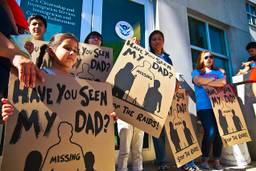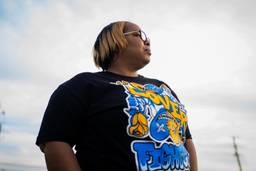Torn Apart: How the Government Separates Parents and Children
Nebraska took Maria Luis’ kids, then ICE sent her back to Guatemala.
Aaron Nelsen

Angelica was born two months premature and carried in that fragile state across the U.S.-Mexico border en route to the meat-processing town of Grand Island, Neb.
In April 2005, after days of refusing food, 1-year-old Angelica had eaten a corn tortilla. “I was happy,” her mother Maria Luis, then 33, recalls.
Maria, an undocumented immigrant, had returned to Grand Island after spending several months tending to her dying mother in Guatemala. She was hoping she could get back her old job at JBS Swift & Company processing plant, pulling nerves from freshly butchered beef.
“Angelica was content in my arms,” Maria remembered. The serenity was interrupted by a knock on the door. Collete Evans, a child welfare employee, and Doug Cline, a Spanish-speaking police officer, stood on her porch. Believing Angelica’s health was improving, Maria had skipped a doctor’s appointment and the doctor had notified Nebraska’s child welfare agency.
Maria panicked. Afraid of losing her children, she identified herself as the babysitter. When the police officer realized the dodge, Maria was arrested for obstructing a government operation and Angelica was torn from her mother’s arms.
Nebraska’s Department of Health and Human Services (DHHS) placed Angelica and her older brother Daniel, then 7, in protective custody. The obstruction charges were dropped and Maria was transferred to U.S. Immigration and Customs Enforcement (ICE) in Grand Island, where she agreed to a voluntary departure from the United States.
A month later, before boarding a plane in Omaha, Maria was informed by immigration authorities that Daniel and Angelica would not be joining her. She was stunned. She had never been told that her children were to remain in Nebraska pending a court hearing regarding custody of the children – a hearing that wasn’t slated to occur until months after her deportation.
Little did she know it would take a five-year legal battle to get her children back, or that she would not only be asked to prove her worth as a mother, but to convince Nebraska officials that Guatemala was a suitable place to raise children.
Confiscated kids
In recent years, thousands of undocumented parents have lost their children after becoming targets of stringent immigration enforcement policies – policies ratcheted up under President Barack Obama. The administration boasts it has deported a record number of undocumented immigrants – nearly 400,000 between Oct. 1, 2010 and Sept. 30, 2011. Even before this increased fervor to deport, poorly coordinated U.S. immigration and child welfare systems created obstacles for undocumented parents and their American-born children. In November, the Applied Research Center (ARC) reported that at least 5,100 children of immigrant parents are currently in state custody while their parents have been detained or deported. ARC also found that between January and June of 2011 more than 46,000 parents of U.S. citizen children were deported – a rate much higher than previous years.
Citizen or no, the U.S. Supreme Court has recognized that parents have a right to custody of their children. To terminate parental rights, courts must find a parent incapable of raising a child because of abuse, neglect or a dangerous home environment. Increasingly, however, undocumented immigrants are losing their children based on provincial – at times racist – interpretations of a child’s “best interest.”
Undocumented parents from Mexico and Central America have been labeled unfit to retain custody of their children based on their inability to fluently speak English, and even Spanish (for many indigenous immigrants from Latin America, Spanish is a second language), or because judges have arbitrarily ruled that their home countries aren’t “as good as” the United States.
Between two worlds
Maria was raised in a poor family in the Mayan community of Joyabaj, nestled in the lush Sierra de Chuacús mountain range, five hours north of Guatemala City. Scratching out a living cleaning homes and raising two sons, in 1997, pregnant with Daniel, Maria left them with her mother and headed north for a factory job in Michigan.
In January 2004, Maria settled in Grand Island. Meat processing wasn’t glamorous work, but at $680 per week, she could make in a day what took more than a month to earn in Guatemala. After expenses, she always had extra to send to her family. But just 15 months after arriving in Grand Island, she sat in immigrant detention, awaiting deportation.
The state still hadn’t found her an attorney or an interpreter to relay the charges against her in her native language of Quiché, a Mayan dialect. Regardless, less than a week after her arrest, Maria appeared unrepresented by counsel in juvenile court. Her only connection to the proceedings was an interpreter who translated them into Spanish – a language she struggled to understand. Maria was accused of failing to provide proper care for her children, a charge she denied.
Weeks later, Maria was on a plane back to Guatemala, and Angelica and Daniel were custodians of Nebraska, a state whose motto is: “Equality Before the Law.”
From Guatemala, Maria was expected to complete a psychological evaluation and parenting classes. Ten months later, Lisa Hannah, a DHHS employee, informed Maria that Nebraska – which is responsible for providing services to parents regardless of their address – had not been able to arrange parenting classes or counseling, so she would “have to take the initiative for that” herself. Maria enlisted the help of a local pastor, Tomas DeJesus, who agreed to set up parenting classes and provide DHHS with progress reports.
Suffering from the separation, Maria wanted to reach her children, but the state failed to provide her with a telephone number for the foster parents, Carlos and Marta Molina. So Maria sought the guidance of another local figure – William Vasey, an American missionary.
As the town’s resident American, Vasey is often sought out for immigration advice, but he had never heard a story quite like Maria’s. Struck by what he called the “plain injustice” of her situation, Vasey also volunteered to serve as a liaison to DHHS. In September 2006, DHHS filed a motion to terminate her parental rights because she had allegedly failed to comply with the case plan designed by Hannah.
Vasey phoned John de Leon, whose law firm represented the Guatemalan Consulate in Miami. De Leon looked further into the matter and was troubled by what he found. The process, he said, “seemed like a deliberate attempt to undermine the basic premise of the law in this country that family reunification should always be the goal.”
Tearing families apart
Immigrant parents pose unique challenges for social workers, like finding translators of indigenous languages or tracking down a parent in ICE detention. The initial 72 hours are a race to reunify, after which the child officially becomes a ward of the state and federally mandated timelines kick in. Often, termination of custody is simply easier for case workers.
Marcia Anne Yablon-Zug, assistant professor of law at the University of South Carolina School of Law, says the pendulum began swinging away from family reunification several years ago. She uncovered nearly 20 cases in which the supposed best interests of children, often U.S. citizens, trumped parental rights. Barriers such as language and culture were being used as justification to sever parental rights.
In a forthcoming article, “Separation, Deportation, Termination,” Yablon-Zug writes that three dubious arguments are regularly used to support claims that termination of parental rights is in the child’s best interest: the parents’ country of origin isn’t safe, the American way of life offers more opportunities and many children have a shot at being adopted by an American family. In the past several years, all three have proven persuasive in courtrooms across the country.
In May 2007, Encarnaci – n Bail Romero, an undocumented Guatemalan, was swept up in a raid on a plant in Butterfield, Mo. She was detained and her 6-month-old son, Carlos, was eventually placed in the custody of an American family. The judge lambasted Bail Romero for “smuggling herself into the country illegally,” which he said was “not a lifestyle that can provide stability for a child.” By contrast, the judge spoke of the prospective adoptive parents in glowing terms, emphasizing that they made a “comfortable living, had rearranged their lives and work schedules to provide Carlos a stable home.”
In November 2008, Cirila Baltazar Cruz, a Mexican mother who speaks Chatino, a little-spoken indigenous language, had her newborn baby, Rub’, taken from her at Singing River Hospital in Pascagoula, Miss. State child welfare authorities claimed that Baltazar Cruz’s lack of English “placed her unborn child in danger and will place the baby in danger in the future.”
Yablon-Zug says such subjective and biased rationales go like this: “Maybe these parents meet the legal definition of ‘fit,’ but where they’re going is not great and it’s not in the child’s best interests, so we’re just going to ignore the whole fitness part and do a straight ‘best interests’ determination.”
In the United States, generations of Indian children have borne the brunt of such separations. The practice of arbitrarily removing native children from their families was officially ended by the Indian Child Welfare Act of 1978, but native people continue to fare poorly in the child welfare system. In many sates there is a high number of Indian children in foster care compared to their percentage of the overall population – in the case of Minnesota, up to 11 times higher.
With rising numbers of parents facing detention and deportation, their families are increasingly vulnerable. Of the more than 2 million people deported between 1998 and 2003, only 8 percent were parents. However, in the first half of 2011, 22 percent of deportees were parents.
Lawyers to the rescue
Nebraska Appleseed, the nonprofit public interest law center in Lincoln, agreed that Maria had a strong case. In 2004, Appleseed had successfully argued a similar case before the state supreme court.
In that case, the mother, Mercedes Santiago Felipe, also Guatemalan, sat in immigrant detention waiting for news about her children; in a courtroom down the hall from her, custody of her children was being decided. Her failure to appear at the hearing was taken as evidence of abandonment, the court ruled to terminate her parental rights, and her children remained in foster care. The error was so absurd that it appeared deliberate.
The Maria case raised more disturbing evidence of indifference from child welfare services and ICE to immigrant families. Months after being deported, Maria readied her modest home in Joyabaj for a home study requested by Nebraska DHHS representatives. She had the basics: beds and bedding, food, pots, pans, running water, electricity and clothing. There were at least three schools and a hospital within walking distance. And between Maria and her two older sons, the family earned an income suitable by Guatemalan standards. The home study, conducted by Vasey, noted that Maria was a respected member of the community. He dispelled concerns about the education and healthcare Angelica and Daniel would receive, remarking that he was impressed with what Maria had been able to provide for her two oldest boys.
Despite Vasey’s enthusiasm, the state ordered a second study, conducted by Josefina Maria Arellano Andrino, a child and adolescent agency supervisor from the Guatemalan Child and Adolescent Agency in Guatemala City. Arellano Andrino affirmed Vasey’s findings, noting that, “in spite of her cultural and low education level, [Maria] has shown [herself] to be a woman that struggles and makes efforts to give her children a better quality life.” It was in the children’s best interest, the report concluded, that they be reunited with Maria.
But neither Arellano Andrino’s nor Vasey’s findings were given their due. During the termination hearing, held more than two years after she was deported, the state of Nebraska called clinical psychologist John Meidlinger to the stand. Meidlinger had never spoken with Maria, but he told the court that if the children were sent to live in Guatemala, they would “experience culture shock, disorientation, fearfulness, sadness and anger.” Daniel would suffer the most, he argued, forecasting long-term anger and confusion, as well as sadness, depression, a sense of alienation, and difficulties forming close and trusting relationships.
Meidlinger also testified against life in Guatemala, which he described as “lower than the standard in the United States” and with “less economic opportunities.”
Judge Phillip M. Martin Jr. questioned whether parental unfitness was even necessary to prove in Maria’s case. Instead, Maria’s trip across the border when Angelica was an infant was cited by Martin as proof that “being in the status of an undocumented immigrant is, no doubt, fraught with peril and this would appear to be an example of that fact.” Martin ordered Daniel and Angelica to remain in the custody of the Molinas in Grand Island.
By now, Daniel and Angelica had begun to refer to Marta and Carlos as “mama” and “papa.” Maria was crushed.
Guatemala: no place to raise a child
Appleseed enlisted the help of Omar Riojas and Chris Huck of DLA Piper, one of the largest law firms in the world, to handle Maria’s appeal. Agreeing to take on the case pro bono, the lawyers decided to bypass the appeals court and ask the state Supreme Court for direct review.
Huck and Riojas argued the state had failed their client from the outset.
Maria had had a right to hear the charges against her in her native tongue and a right to consular notification, guaranteed by the Vienna Convention. In this case it might have helped her obtain pro bono counsel to secure a stay of deportation or directed Nebraska to provide services to her in Guatemala.
The state had even botched a routine task: Maria not only had a right, but was required, to make regular telephone calls to her children, yet months after she was deported she was still not provided with the number of the foster parents.
In June 2009, the Supreme Court unanimously reversed Judge Martin’s ruling. While mindful that the children would be uprooted, the justices stated:
We are not free to ignore Maria’s constitutional right to raise her children in her own culture and with the children’s siblings. That the foster parents in this country might provide a higher standard of living does not defeat that right.
Judge Martin was also the judge whose ruling terminated Santiago-Felipe’s parental rights. Asked about his ruling in Maria’s and Santiago Felipe’s cases, he told In These Times that the state had made a persuasive argument that life in Guatemala was not in the best interests of the children.
A family reunited
On a frigid December evening in 2009, five years after being deported from Nebraska, Maria’s plane touched down in Omaha. Huck, De Leon and Riojas had gathered to greet her. But Maria thought only of seeing her children. The four of them piled into a rented car and headed to Grand Island. It was past 10 p.m., but the attorneys called ahead to arrange for Angelica and Daniel to meet them at the Holiday Inn.
“I think a part of us thought the children would cry, be scared or resent Maria or not know how to react,” Riojas said. But Daniel and Angelica leapt into their mother’s arms.
Riojas, his eyes brimming with tears, said, “I realized the importance of a parental bond that can’t be broken.”
Despite the fact that the state’s Supreme Court had sided with Maria, Nebraska’s DHHS drafted another case plan requiring her to fulfill a number of conditions before the reunion could occur. Incredibly, one of the conditions required Maria to hold a steady job in the United States, which, of course, her temporary visa did not allow. It was a plan designed to fail.
“On the one hand the state was asking her to get a job, which meant breaking the law; on the other they may have used this as a reason not to reunify her with her children,” Riojas said. “She was in a Catch-22.”
“Had we just left her that Saturday and said, ‘Thanks, Maria, it was nice meeting you. Congratulations. Good luck in life,’ she wouldn’t have gotten her kids back,” added Riojas.
They stayed for a week, raising several thousand dollars from friends so that Maria could rent an apartment, buy a couch, beds and kitchenware – all required by DHHS for a successful reunion. Maria still had to convince DHHS she could nurture a suitable environment for children in the United States before the agency would allow Angelica and Daniel to move in with her.
Angelica, who Maria hadn’t seen in years, was now a bright-eyed, precocious 6-year-old; Daniel had grown into a shy adolescent with shortly cropped hair who felt responsible for his little sister.
The initial joy of the reunion gave way to more difficult interactions. The adjustment after so much time apart, was difficult, especially for Angelica, who had grown attached to the Molinas.
“My daughter didn’t want me,” Maria said sadly. “She didn’t want to talk to me or let me touch her. She said I wasn’t her mother.”
Daniel reassured his sister that everything would be alright. “I was angry,” Angelica said, her lips glistening with the residue from an orange-flavored Popsicle. “To me, she wasn’t my mom.”
Maria was eventually granted a temporary work visa that allowed her to hold down a steady job at the same meat processing plant and meet the conditions of the DHHS case plan.
After a year and a half, and several unsuccessful attempts to have her visa extended, in August, Maria got the call from ICE. Her request for a visa extension was denied and she and her kids had two weeks to pack their belongings and leave for Guatemala.
Research support for this article was provided by The Investigative Fund at The Nation Institute and the Puffin Foundation.






